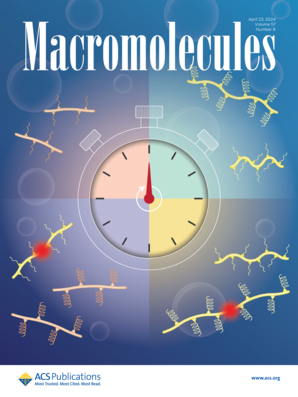模拟重现实验膨胀系数的甲基丙烯酸甲酯基聚合物刷的粗粒度参数
IF 5.1
1区 化学
Q1 POLYMER SCIENCE
引用次数: 0
摘要
与自由聚合物相比,聚合物刷具有独特的结构和动态特性,这是由于它们的局限性和栓系性。虽然自由聚合物的粗粒度(CG)模型在文献中已经建立,但它们在聚合物刷中的直接应用是有限的。这是因为刷子表现出独特的构象行为、缩放定律和对环境刺激的反应,而这些可能无法通过为自由聚合物开发的模型准确捕获。我们系统地评估了基于甲基丙烯酸甲酯的聚合物刷在MARTINI v3力场内的化学特定CG参数。我们发现,大多数CG参数分配导致刷链过度卷曲,并且计算的膨胀系数SC与所使用的水模型(RW, SW和TW)有很强的依赖性。我们将这些问题追溯到聚合物-聚合物和聚合物-水相互作用之间的不平衡。修正后的参数集准确地再现了不同接枝密度、pH响应性、电荷和亲水性的甲基丙烯酸甲酯基刷的实验膨胀系数,即聚(二甲氨基乙基甲基丙烯酸酯)(pDMAEMA)、聚((2-甲基丙烯氧基)-乙基三甲基氯化铵)(pMETAC)、聚[2-(甲基丙烯氧基)乙基二甲基-(3-磺基丙基)]氢氧化铵(pMEDSAH)和聚(3-甲基丙烯酸磺基)(pSPMA)。此外,这些参数减轻了电刷链的过度卷曲和对水模型的依赖,确保了实验数据的更好再现性,并与理论电刷模型保持一致。本文章由计算机程序翻译,如有差异,请以英文原文为准。

Coarse-Grained Parameters for Simulations of Methyl-Methacrylate-Based Polymer Brushes That Reproduce Experimental Swelling Coefficients
Polymer brushes exhibit unique structural and dynamic properties compared to free polymers due to their confined and tethered nature. While coarse-grained (CG) models for free polymers are well-established in the literature, their direct application to polymer brushes is limited. This is because brushes demonstrate distinct conformational behaviors, scaling laws, and responses to environmental stimuli that may not be accurately captured by models developed for free polymers. We have systematically evaluated chemically specific CG parameters within the MARTINI v3 force field for methyl-methacrylate-based polymer brushes. We have found that the most CG parameter assignments led to an excessive coiling of the brush chains and a strong dependence of the calculated swelling coefficient SC with the water model used (RW, SW, and TW). We traced these issues to an imbalance between polymer–polymer and polymer–water interactions. The revised parameter set accurately reproduced experimental swelling coefficients for methyl-methacrylate-based brushes with varying grafting densities, pH responsiveness, charge, and hydrophilicity, namely, poly(dimethylaminoethyl methacrylate) (pDMAEMA), poly((2-methacryloyloxy)-ethyl trimethylammonium chloride) (pMETAC), poly[2-(methacryloyloxy)ethyl dimethyl-(3-sulfopropyl)] ammonium hydroxide (pMEDSAH), and poly(3-sulfopropyl methacrylate) (pSPMA). Furthermore, these parameters mitigated brush chain hypercoiling and dependence on the water model, ensuring better reproducibility of experimental data and alignment with theoretical brush models.
求助全文
通过发布文献求助,成功后即可免费获取论文全文。
去求助
来源期刊

Macromolecules
工程技术-高分子科学
CiteScore
9.30
自引率
16.40%
发文量
942
审稿时长
2 months
期刊介绍:
Macromolecules publishes original, fundamental, and impactful research on all aspects of polymer science. Topics of interest include synthesis (e.g., controlled polymerizations, polymerization catalysis, post polymerization modification, new monomer structures and polymer architectures, and polymerization mechanisms/kinetics analysis); phase behavior, thermodynamics, dynamic, and ordering/disordering phenomena (e.g., self-assembly, gelation, crystallization, solution/melt/solid-state characteristics); structure and properties (e.g., mechanical and rheological properties, surface/interfacial characteristics, electronic and transport properties); new state of the art characterization (e.g., spectroscopy, scattering, microscopy, rheology), simulation (e.g., Monte Carlo, molecular dynamics, multi-scale/coarse-grained modeling), and theoretical methods. Renewable/sustainable polymers, polymer networks, responsive polymers, electro-, magneto- and opto-active macromolecules, inorganic polymers, charge-transporting polymers (ion-containing, semiconducting, and conducting), nanostructured polymers, and polymer composites are also of interest. Typical papers published in Macromolecules showcase important and innovative concepts, experimental methods/observations, and theoretical/computational approaches that demonstrate a fundamental advance in the understanding of polymers.
 求助内容:
求助内容: 应助结果提醒方式:
应助结果提醒方式:


